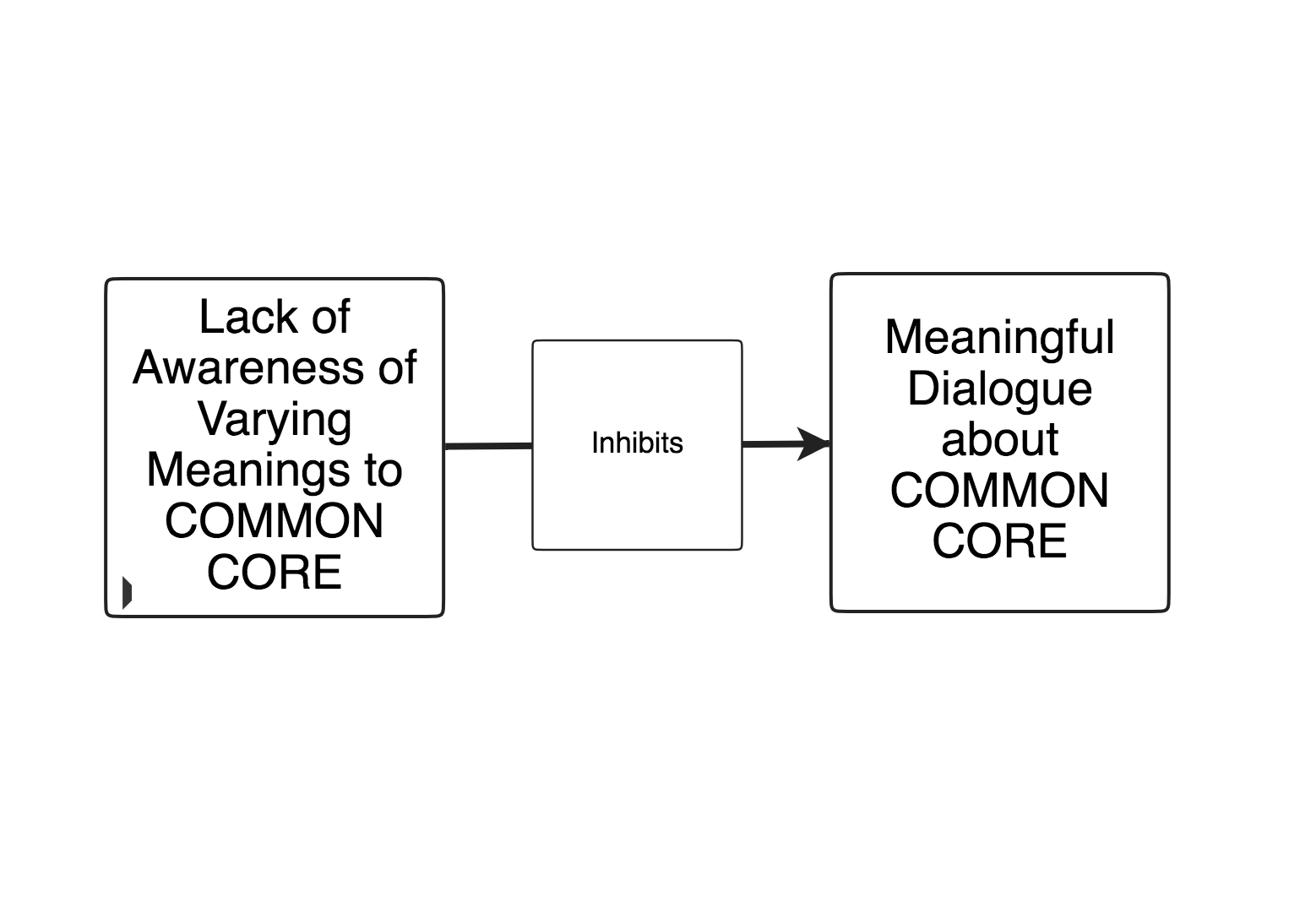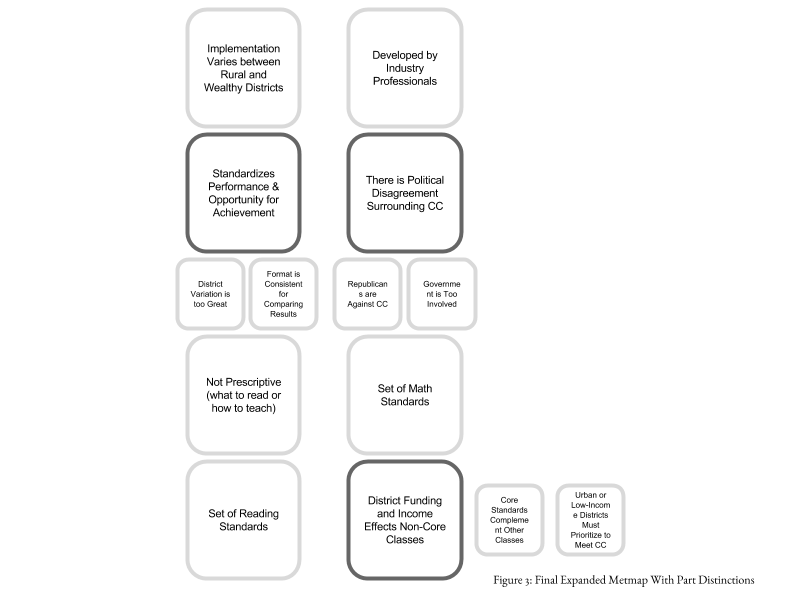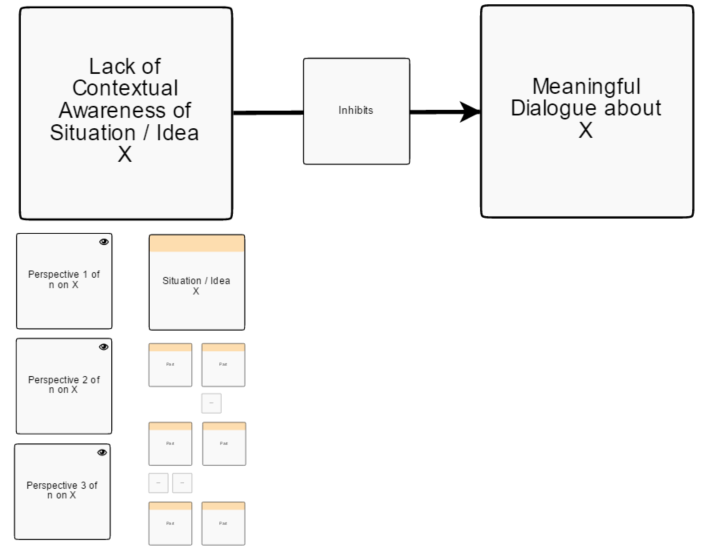Introduction
Introduced in 2009, the Common Core State Standards Initiative (Common Core, Core, or CC) is the most recent and most broad-scale attempt to create national standards for primary and secondary school students in the United States. The plan was chartered by the National Governor’s Association’s (NGA) Center for Best Practices and the Council of Chief State School Officers (CCSSO) with the goal of creating a framework that, beginning in kindergarten, effectively outlined levels of college and career readiness for students at the end of high school.[1] Not soon after its inception, varying groups of individuals—from politicians to foundation analysts—began criticizing and lauding the Common Core’s purpose and methodologies. Among the more frequently heard arguments against the Common Core is that it is prescriptive: opponents state that it mandates which specific books or mathematics lessons educators must use. This charge is factually incorrect, as the CC only makes recommendations and suggestions, not mandates, for curricula. Another point of opposition is that, theoretically, the CC provides a “level playing field” for all students, in the pursuit of which it creates a linear, by-the-numbers style of education that pigeonholes educators into a narrow range of resource options (such as textbooks or curricula).[2]
These differences in perspective between opponents and proponents of the Common Core seem easy to identify, so why does it seem we can’t have any kind of meaningful national dialogue about the Core? Because the problem of varying perspectives transcends the perspectives themselves and results in parties’ assigning different meanings to the same distinction; a proponent may assign a meaning to CC math standards as ‘structured,’ where opponents may assign a meaning of ‘restrictive’ to the same distinction. For the purpose of this case, these involved parties are grouped for the most part into proponents and opponents. There is most certainly within-group variance, but the case does not focus on that particular level of differentiation. Proponents and opponents each focus on some parts of the Common Core, to the exclusion of the other. This identity-other exclusion can even extend into a failure to recognize the parts of a part, or the concept that there are additional, more detailed meanings to a larger or overarching concept.
Figure 1
Collapsed Metamap Showing Inhibited Dialogue Relationship

By failing to acknowledge the presence of these more nuanced sub-meanings, it inhibits the members of each side from having any kind of meaningful dialogue – they might as well be talking about two different phenomena altogether. This case will focus on the concept of a ‘meaningful dialogue,’ by which I mean an exchange of ideas which results in one or both parties gaining an additional understanding of the topic(s) at hand – instead of simply talking their individual ideas at one another. Figure 1 illustrates a metamap, a visual system to define relationships and organize relevant content within a particular system. This ‘collapsed’ metamap, meaning none of the lower-level distinctions are being shown, illustrates the general relationship, where a lack of awareness or understanding that ‘Common Core’ standards can connote multiple kinds of intervention actually inhibits any meaningful dialogue from occurring.
Simple Does Not Always Mean Easy
The idea that perspectives are ubiquitous—and that this very fact makes problems so “wicked”—was originally discussed by Dr. Derek and Dr. Laura Cabrera in Systems Thinking Made Simple.[3] The notion of what makes a problem ‘wicked’ was originally discussed by C. West Churchman in his guest editorial for Management Science in 1967. In it, Churchman discusses a wicked problem being one which is “…ill-formulated, where the information is confusing, where there are many clients and decision makers with conflicting values, and where the ramifications in the whole system are thoroughly confusing.” Having the ability to recognize and adopt numerous perspectives is an invaluable skill for diagnosing, diagramming, and solving complex issues. The simple fact that there are multiple perspectives from which to view any given problem can lead to misunderstandings between groups since the distinctions people make often depend upon their particular perspectives. When viewing a system as a whole with multiple parts, one perspective can see all, none, or some of the parts that another perspective sees. As the system becomes more complex, perspective-driven differences in distinction making often make it more difficult to reconcile how a system and its parts are understood. A Democrat and a Republican may agree that what falls from an apple tree is an apple, but the subject of that orchard’s role in the local economy (the economy itself being an even more complex system) would more likely produce discord.
When I first diagrammed the debate surrounding Common Core, I distinguished numerous perspectives. The original map incorporated so many perspectives that it became incredibly difficult to distinguish clear relationships or paths between them. The frustration of trying to map this complex system helped me recognize our tendency to use the perspectives of people–or at least living things–as the starting-points of our analysis, but these distinct perspectives do not necessarily match distinctions between stakeholders. A teacher and a parent, for example, may both feel the Common Core’s standards toward increasing mathematics performance are too demanding, thus sharing a point of opposition to the Core. This realization threw a stick in the spokes of my original map’s design and led me to a thought transformation. People of different demographic characteristics can share common conceptual perspectives—in this case regarding the Common Core—which shifts how I identify relevant perspectives. Originally, my way of thinking was centered around demographics: that the CC may be opposed by parents and favored by teachers (or vice versa), or that, as a group, students may wish certain standards of the Core to be changed while district administrators may feel opposite. The original set of demographic perspectives might be correct for a broader study of education policy, the historical context of education in America, or even political aspects of education policy, but it did not reach the heart of the misunderstandings over Common Core.[4][5] Mapping the system prompted an evolution of my method: instead of treating perspectives as synonymous with stakeholders, and thus mapping demographic-focused points, I began to distinguish based on conceptual constructs, mapping concept-based points.
Figure 2
Expanded Metamap Showing Two Conceptual Perspectives

The second metamap framing (see Figure 2) changed the demographically-bounded perspectives to the much broader perspective groupings of proponents and opponents. The number of perspectives on the map may seem oversimplified at only four, but in fact, the number represents the evolution of multiple perspectives. The lack of understanding that there are multiple meanings to the parts of Common Core inhibits the possibility of a meaningful dialogue between perspectives. The varying parties’ perspectives on the parts of Common Core inhibit meaningful conversation because different people are using assigning different meanings to the same distinction. But this discrepancy can be redressed. In fact, these differences can help build a mental model that contains the factual elements of Common Core while also taking into account the differences of perspective and thereby expanding what is distinguished within the Common Core system (Figure 2) by these perspectival part-whole structures. Though this new design of the metamap serves to highlight the distinctions over which parties disagree, it also furthers the analytical process. By making clear the distinctions of Common Core which are shared between proponents and opponents, it allows for the elucidation of additional part-whole relationships.
Figure 3
Final Expanded Metamap Showing Parts-of-Parts
 Figure 3 depicts the Common Core concept expanded after my thought transformation: the varying distinctions are elucidated, including three instances where there are parts to the parts of the whole (the whole being Common Core, not pictured in Figure 3 due to formatting constraints). As was true of the number of possible perspectives mapped in the previous section, the distinctions here are by no means exhaustive. Perspectives can make different distinctions on the same exact concept, be it the larger whole of Common Core, or even a number of its parts. Observing the expanded list, certain distinctions represent the factual evidence gathered from the National Governors Association Center for Best Practices regarding the creation of the standards themselves. Also represented in the map are fact-based statements about Common Core relating to its implementation and who developed it. Three examples of deconstructing part-whole systems examine the extant political biases concerning the viability of Common Core, the district funding/locale wealth construct, and the idea that the Common Core standardizes performance measures across districts.
Figure 3 depicts the Common Core concept expanded after my thought transformation: the varying distinctions are elucidated, including three instances where there are parts to the parts of the whole (the whole being Common Core, not pictured in Figure 3 due to formatting constraints). As was true of the number of possible perspectives mapped in the previous section, the distinctions here are by no means exhaustive. Perspectives can make different distinctions on the same exact concept, be it the larger whole of Common Core, or even a number of its parts. Observing the expanded list, certain distinctions represent the factual evidence gathered from the National Governors Association Center for Best Practices regarding the creation of the standards themselves. Also represented in the map are fact-based statements about Common Core relating to its implementation and who developed it. Three examples of deconstructing part-whole systems examine the extant political biases concerning the viability of Common Core, the district funding/locale wealth construct, and the idea that the Common Core standardizes performance measures across districts.
Hidden Parts
There are two variations presented in the metamap. The first system map depicts the relationship between groups in favor of or in opposition to the Common Core. Again, many sub-perspectives have been excluded from the visualization here, for simplicity. Both groups taking perspectives in this variation see the basic components of CC, including that it is a set of both math and reading standards. Opponents, however, do not observe the distinction that Common Core is not prescriptive. This illustrates a key point in the system: just because a perspective fails to observe a distinction does not mean the distinction does not exist. Similarly, Common Core proponents often overlook the fact that implementation or the degree to which the Core can be integrated into the school can vary between districts in poor or wealthy locales. Even more troublesome is when observing only one perspective precludes the observation of different parts of the system; this results in lack of communication, incomplete planning of enactment, or inequitable distribution of educational opportunity to students. One example of such a part within a part construct is shown in Figure 4.
Figure 4
When Perspectives Assign Different Meaning to the Same Distinction

Some opponents of the Common Core—often conservative individuals—adopt the view that the government is too involved in child development and learning. Some proponents—often liberal individuals—of the Common Core adopt the view that all Republicans are against the CC. It can also be argued that neither perspective sees the overarching whole to these parts, which is that there is a political bias toward whether or not the Common Core is politically viable and, thus, the presentation of its benefits/drawbacks are subsequently skewed. Both proponents of and opponents of the Common Core system may acknowledge that their colleagues across the aisle have a certain view on the CC, but they often fail to acknowledge the specific parts of the whole each point chooses to emphasize. This means they stop short of reaching a level of awareness which would result in a meaningful dialogue. Dialogue is essential to the process of education policy implementation, especially given the Every Student Succeeds Act passed in 2015. President Obama’s hallmark education legislation, this law includes many provisions, one of which prohibits states from “actively coercing or suggesting the adoption of” the Common Core[6]. Now that state governments as a single entity are prohibited from pushing the adoption of the CC or similar systems, there must be bipartisan communication across the board, firstly at the community/state level, if any improvements to the education system are to be realized.
Instead of viewing Common Core through the perspective of proponents and opponents, the second structure visualizes the Core both in theory and in practice, or suggestion versus implementation. Though I did not structure this arrangement to compare those who designed CC to those who implement it, that could be a valid interpretation. In theory, the Common Core is built to be purely a set of guidelines, with recommended texts for English Language-Arts coursework and general goals for mathematics. In practice, however, due to a variety of factors (budgetary, administrative, and/or community-pressure-related), that intended implementation is not always achieved by schools and administrators. This brings us to a critical component of the Common Core controversy: profit motive. During the 2008 recession, many school districts across the country experienced a reduction in local capacity (the availability of resources to pay for teachers’ salaries or the resources to provide for student enrollment capacity) as a result of cuts in state aid. These cuts were nearly simultaneous with the launch of the Race to the Top program, which heavily emphasized assessment, including that of administrators and teachers. Focus on aligning internal assessments, combined with the passing of the 2% cap on local tax levies, continued to put financial pressure on districts—to the tune of nearly 14,000 teachers’ jobs.[7] This pressure, including the loss of jobs, is a real example of failure to account for multiple perspectives. At the very time faculty needed additional support in learning, adapting to, and implementing the Common Core, districts’ capacities were being severely reduced because of focuses on other assessments.
By mapping the perspectives of various groups regarding the parts of the Common Core, it can be observed that while there are commonalities among those perspectives, there are also key differences. These differences are a result of distinction problems, as mentioned earlier.
For example, when viewed from the perspective of a CC proponent, one benefit of Common Core is that it enables comparison of various performance metrics across districts. The proponent perspective doesn’t observe the part to the same whole which is taken by the opponent perspective: the Common Core’s standards may be a way to standardize measures of performance, but more nuanced variation between schools, such as resource levels and community wealth, makes such standardization a misleading methodology.
Figure 5
When Perspectives Assign Different Meaning to the Same Distinction

Even harder to reconcile is when individuals observing perspectives make distinctions that only recognize a part and not the whole. Figure 5 illustrates this scenario. The same part-whole example used above, when viewed through the theory vs. practice system, illustrates this failure to view wholes. In practice, data show that the Common Core can be costly to implement for districts that are poorly funded or have aging facilities.[8] This part (Urban or Low-Income Areas Must Prioritize to Meet Core Standards) of the district funding whole is depicted from the in practical perspective. Urban and low-income districts often struggle to institute the necessary curricula, faculty, and material changes to implement Common Core standards. As a result, those districts are left with fewer dollars to retain programs such as arts, music, or other disciplines traditionally viewed as less academic—they must prioritize. A suburban or wealthy district may have sufficient funds to avoid making this change, thereby retaining the more diverse range of classes. This discrepancy clearly affects students in both of those groups differently.
The entirety of district funding’s effects, however, is not included in the theory perspective at all. The theory perspective only accounts for the benefit of CC standard classes complementing students’ other activities. The fact that differences in district funding may cause certain students to lose out on those complementary activities is only observed by the “in practice” perspective. Whether viewed by proponents and opponents or through the lenses of theory and practice, certain commonalities regarding the CC exist between these perspectives’ distinctions: for example, the fact that the Common Core is a set of reading and math standards, or that there are political concerns regarding the Core’s viability. These commonalities add to our understanding of the differences by illustrating there are indeed areas of mutual understanding that could lead to meaningful dialogue. The fact that these perspectives share common definitions, in and of itself, doesn’t resolve the problem. It is, however, a useful starting point. Having a conversation which doesn’t begin with distinction errors and ignorance of the other side’s perspective is a meaningful step forward. Such a conversation also mitigates the chances of lock-in and reminds us of the ethical ramifications of perspective-taking by forcing us to think from the other’s point of view and how we might ourselves be affected by the proposal(s) at hand.
The argument for and against standardization in school, curricula or otherwise, is still ongoing and mapping the perspectives of opponents, proponents, theorists, and practitioners illuminate the debate’s power to divide communities over what should be a shared vision: the excellent education of students. Some communities in favor of standardization maintain that it equalizes opportunities between traditionally disadvantaged and advantaged students. Others argue that this stance underrepresents the challenges faced by disadvantaged students and, in turn, only serves to embolden potentially oppressive instructors. These two disparate views can only begin to be discussed if there is a level of common understanding between the parties who hold them. By adopting a systems-thinking mindset, even the most politically-, socially-, or theologically-charged problems can at least be structured, analyzed, and observed in a way which allows for civil discourse.
Structural Transfer
In mapping the Common Core system according to different sides’ perspectives and associated distinctions, it became evident that the specific ideas (Common Core) could be removed from the framework, and a reusable pedagogical tool would remain. This framework, resulting from a process known as structural transfer, allowed me to create a cognitive map, which can be used for a variety of deadlocked issues that inhibit meaningful dialogue. Figure 6 depicts one version of such a map.
Figure 6
An Example of a Cognitive Jig

When n number of individuals lack understanding of the different perspectives regarding situation or idea X, there exists in those n individuals an inability to adopt other perspectives. This lack of awareness directly inhibits the possibility of a meaningful dialogue on X. One or more of the n perspectives may see parts, wholes, and/or subparts within X, and those emphases may subsequently cause them to identify the system differently; just as proponents and opponents of Common Core view the concept in vastly different ways. By illustrating these varying distinctions and mapping how different points have different views on the components of X, commonalities can be observed in any setting – politics, classroom life, personal relationships.
Conclusions
Just because two groups are having a discussion on the same topic doesn’t mean they’re discussing the same thing. As we’ve observed, whether the two groups are opposing each other or they’re seemingly pushing for the same idea, distinctions matter. Similarly, where distinctions are concerned, perspectives matter. As expected, proponents of the Common Core view some parts of the system differently than opponents. What we also observed, however, is that some parts (what comprises the whole) on which the two groups disagreed were actually different subparts to the same whole. This underscores the importance of contextual awareness in fully explicating the components of a situation or idea. By being aware of varying contexts, often the result is parties with differing perspectives finding a commonly understood part to discuss, or one party realizing a component that was previously overlooked.
Image 1
“The distinctions we make depend on the perspectives we take.” – Dr. Derek Cabrera

This case, through the use of systems thinking methods, may not determine a clear “right” or “wrong”; rather its strength is its ability to provide a framework to generate meaningful dialogue regarding difficult or polarizing issues. The framework presented here also illustrates that taking perspectives, especially those dissimilar to your own, presents an opportunity to gain valuable insight, which can, in turn, better inform your own decisions. By being mindful of whether a group has assigned different meanings to the same part of a situation or idea, you can facilitate meaningful dialogue.
References
- NGA, 2010 ↑
- VanTassel-Baka, 2015 ↑
- Cabrera & Cabrera, 2015 ↑
- ACT, 2011 ↑
- Murphy, 2015 ↑
- Mathis, 2016 ↑
- Wastvedt, 2015 ↑
- VanTassel-Baska, 2015
Works Cited
ACT. (2011). The condition of college and career readiness, 2011. Iowa City, IA: Author. Retrieved from www.act.org/research/policymakers/cccr11/pdf/ConditionofCollegeandCareerReadiness2011.pdf
Cabrera, D., & Cabrera, L. (2015). Systems thinking made simple: New hope for solving wicked problems.
Fieg, J. P., & Mortlock, E. (1989). A Common Core: Thais and Americans. Intercultural Press, Inc., PO 700, Yarmouth, ME 04096.
Hetland, Lois, and Ellen Winner. “The arts and academic achievement: What the evidence shows.” Arts Education Policy Review 102, no. 5 (2001): 3-6.
King, J. E. (2011). Implementing the Common Core State Standards: An Action Agenda for Higher Education. State Higher Education Executive Officers.
Mathis, W. J., & Trujillo, T. M. (2016). EVERY STUDENT SUCCEEDS ACT.
Murphy, M. M. (2015). Plato’s Philosophy of Education and the Common Core Debate
National Governors Association Center for Best Practices, Council of Chief State School Officers. 2010. Common Core State Standards. National Governors Association Center for Best Practices, Council of Chief State School Officers, Washington D.C.
National Research Council. Common Standards for K-12 Education?: Considering the Evidence: Summary of a Workshop Series. National Academies Press, 2008.
Rothman, Robert. “A common core of readiness.” Educational Leadership 69, no. 7 (2012): 10-15.
Stillwell, Robert, and Jennifer Sable. “Public School Graduates and Dropouts from the Common Core of Data: School Year 2009-10. First Look (Provisional Data). NCES 2013-309rev.” National Center for Education Statistics (2013).
VanTassel-Baska, Joyce. “Arguments for and against the common core state standards.” Gifted Child Today 38, no. 1 (2015): 60-62.
Wastvedt, Solvejg. (12-18-2015). Three Things to Know about NY Education Changes. WSKG News.





